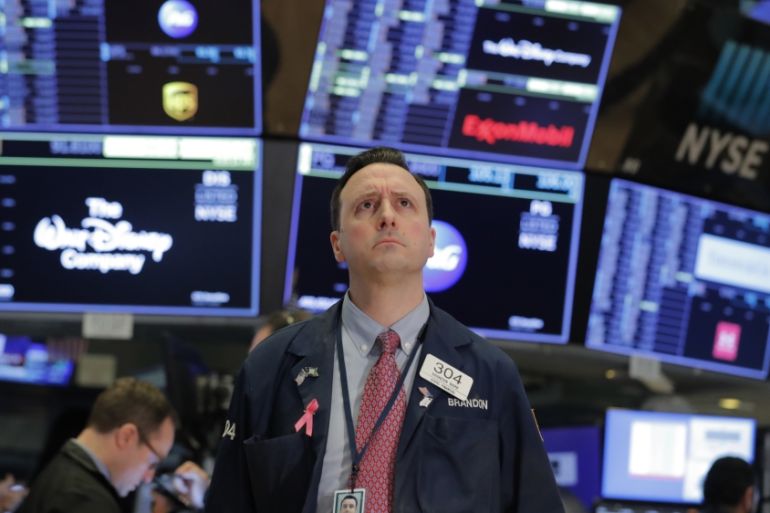US stocks nosedive as Fed fails to stem virus fears
The S&P 500 tanked more than 7 percent at open, triggering circuit breakers that halt trading for 15 minutes.

United States stocks sold off sharply on Monday, as the Federal Reserve’s surprise interest rate cut and other measures designed to shore up the economy against an onslaught of coronavirus disruptions failed to stem deepening fears.
The S&P 500 – a reflection of the health of US pension accounts and college savings plans – fell 8.1 percent at the opening bell in New York, triggering so-called circuit breakers that halt trading for 15 minutes. When trading resumed, losses extended, sending the index down 11 percent before it started digging out of that hole.
Keep reading
list of 3 itemsWhat we know so far about coronavirus
Coronavirus: All you need to know about symptoms and risks
The Dow Jones Industrial Average plummeted more than 2,200, or 9.7 percent, at the open of trading, while the Nasdaq Composite Index tanked 6.1 percent. Both indexes continued falling when trading resumed but started to pare losses in late morning trading.
Other markets are falling under heavy stress.
Precious metals – often seen as a safe haven during turbulent times – were not spared from the carnage, with spot gold prices down 3.8 percent at $1,470.28 an ounce.
Bitcoin also came under pressure after the Fed’s emergency moves, plunging as much as 18 percent before clawing back some of those losses.
The Fed pulled pages from its crisis-era playbook on Sunday, slashing interest rates to near zero and unleashing a handful of other measures designed to keep credit markets – which have been showing signs of stress in recent weeks – running smoothly.
Among the measures – the Fed decided to restart the programme of buying bonds from the US Treasury and mortgage-backed securities markets. By supporting the smooth functioning of these markets, the Fed is attempting to help businesses and consumers access the credit they need to weather the coronavirus storm.
The Fed also slashed reserve requirements for thousands of US banks and eased conditions for banks at the discount window – again with the aim of helping financial institutes more easily meet the demand for credit from households and businesses straining under the pressure of disrupted activity.
On a more global scale, the Fed in concert with five other central banks reduced the pricing on dollar swap lines to ensure that there is a sufficient amount of US dollars – the global reserve currency – to ensure that the markets for borrowing and lending greenbacks overseas do not become overly strained. If these markets seize up, it could feedback into the US economy.
But with so many unknowns surrounding the coronavirus outbreak, investors took little solace from the Fed’s extraordinary actions.
“As the scale of the economic and market disruption wrought by the coronavirus becomes clear, it seems likely that investors will increasingly start to question whether policymakers have already exhausted their capacity to respond,” Capital Economics group chief economist Neil Shearing wrote in a client note this morning. “As we have noted before, history suggests that equity markets are only likely to bottom out when it becomes clear that the flow of new cases of the virus has peaked.”
Federal Reserve Chairman Jerome Powell told reporters on Sunday that he expects the US economy to post modest growth in the first three months of this year, but then experience a contraction in the second quarter. Beyond that, the Fed is in a wait-and-see mode. A recession is defined as two consecutive quarters, or six straight months, of negative economic growth.
Interest rate-sensitive financial stocks led the charge lower on Wall Street as shares of JPMorgan Chase, Morgan Stanley, Citigroup and Bank of America all saw double-digit percent declines in early trading.
Energy stocks were also under pressure again as the price of global benchmark Brent crude tanked approximately 10 percent to fall below $30 a barrel before recovering some ground.
And airline stocks continued to get pummeled as carriers slash services, cut costs and temporarily lay off workers.